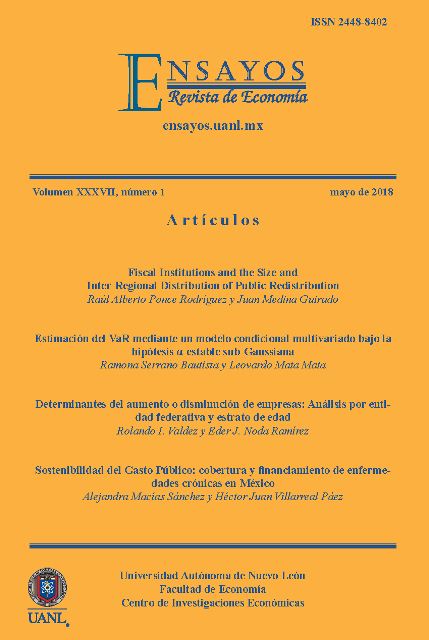Determinantes del aumento o disminución de empresas: Análisis por entidad federativa y estrato de edad
Determinants of the Increase and Decrease in the Number of Firms: An Analysis by State and Age Stratum
DOI:
https://doi.org/10.29105/ensayos37.1-3Palabras clave:
Edad de empresas, Determinantes, Datos panelResumen
En este trabajo, se pone a prueba la hipótesis de que los mismos factores afectan de manera distinta el aumento o disminución de empresas, según su edad. Para ello, se usan dos modelos de datos panel, cuya variable dependiente es el estrato de edad de la empresa: recién nacida, joven, adulta y mayor. En total, se estiman ocho ecuaciones utilizando variables explicativas de tipo económico y social. Entre los resultados más importantes destaca que el PIB, PIB per cápita, la TIIE, la Tasa de interés bancaria y la liquidez de la economía ejercen el mismo efecto, ceteris paribus, sobre la cantidad de empresas, independientemente de su edad. No obstante, la migración y la inseguridad afectan solo a las empresas recién nacidas y a las jóvenes.
Descargas
Citas
Acs, Z. J., Desai, S., y Hessels, J. (2008). Entrepreneurship, economic development and institutions. Small Business Economics(31), 219-234. doi:10.1007/s11187-008-9135-9
Audretsch, D. B., y Acs, Z. J. (1994). New-Firm Startups, Technology, and Macroeconomic Fluctuation. Small Business Economics(6), 439-449.
Bates, T. (1990). Entrepreneur Human Capital Inputs and Small Business Longevity. The Review of Economics and Statistics, LXXII(4), 551-559.
Benavente, J. M., y Külzer, C. (2008). Creación y destrucción de empresas en Chile. Estudios de Economía, 35(2), 215-239.
Bhattacharjee, A., Higson, C., Holly, S., y Kattuman, P. (2009). Macroeconomic Instability and Business Exit: Determinants of Failures and Acquisitions of UK Firms. Economica(76), 108-131. doi:10.1111/j.1468-0335.2007.00662.x
Boeri, T., y Bellmann, L. (1995). Post-entry behaviour and the cycle: Evidence from Germany. International Journal of Industrial Organization, 13, 483-500.
Dunne, P., y Hughes, A. (1994). Age, size, growth and survival: UK companies in the 1980s. The Journal of Industrial Economics, XLII(2), 115-140.
Evans, D. S. (June de 1987). The relationship between firm growth, size and age; Estimate sfor 100 manufacturing industries. The Journal of Industrial Economics, XXXV(4), 567-581.
Fort, T. C., Haltiwanger, J., Jarmin, R. S., y Miranda, J. (2013). How Firms Respond to Business Cycles: The Role of Firm Age and Firm Size. IMF Economic Review, 61(3), 520-559. doi:10.1057/imfer.2013.15
Garcia-Quevedo, J., Pellegrino, G., y Vivarelli, M. (2014). RyD drivers and age: Are young firms different? Research Policy, 1-13. doi:http://dx.doi.org/10.1016/j.respol.2014.04.003
Hernandez-Trillo, F., Pagan, J. A., y Paxton, J. (2005). Start-up Capital, Microenterprises and Technical Efficiency in Mexico. Review of Development Economics, 9(3), 434-447.
Highfield, R., y Smiley, R. (1987). New business starts and economic activity. International Journal of Industrial Organization, 5, 51-66.
Holtz-Eakin, D., Joulfaian, D., y Rosen, H. S. (Feb de 1994). Sticking it Out: Entrepreneurial Survival and Liquidity Constraints. The Journal of Political Economy, 102(1), 53-75.
Huynh, K. P., y Petrunia, R. J. (2010). Age effects, leverage and firm growth. Journal of Economic Dynamics y Control(34), 1003-1013. doi:10.1016/j.jedc.2010.01.007
Ilmakunnas, P., y Topi, J. (1999). Microeconomic and Macroeconomic Influences on Entry and Exit of Firms. Review of Industrial Organization(15), 283-301.
INEGI. (2014). Micro, pequeña, mediana y gran empresa: estratificación de los establecimientos. Instituto Nacional de Estadística, Geografía e Informática, Aguascalientes.
Liu, J. (2004). Macroeconomic determinants of corporate failures: evidence from the UK. Applied Economics(36), 939-945. doi:10.1080/0003684042000233168
Mansfield, E. (1962). Entry, Gibrat's Law, Innovation and The Growth of Firms. The American Economic Review, 52(5), 1023-1051.
Mungaray, A., y Ramírez-Urquidy, M. (2011). Full and part-time entrepreneurship and the supply of entrepreneurial effort: Evidence from mexican microenterprises. Journal of Developmental Entrepreneurship, 16(4), 441-458. doi:10.1142/S1084946711001938
Pfaffermayr, M., Stockl, M., y Winner, H. (2013). Capital Structure, Corporate Taxation and Firm Age. Fiscal Studies, 34(1), 109-135.
Pfeiffer, F., y Reize, F. (2000). Business start-ups by the unemployed - an econometric analysis based on firm data. Labour Economics(7), 629-663.
Rangel, E., y Torre, L. E. (2015). Determinants of the cost of starting a business in Mexico. North American Journal of Economics and Finance(34), 430-449.
Sanchez-Vidal, J., y Martin-Ugedo, J. F. (2008). Edad y tamaño empresarial y ciclo de vida financiero. (S. Instituto Valenciano de Investigaciones Económicas, Ed.) Cartagena, Murcia, España.
Tornhill, S., y Amit, R. (2003). Learning about Failure: Bankruptcy, Firm Age, and the Resource-Based View. Organization Science, 14(5), 497-509.
Wooldridge, J. M. (2016). Introductory Econometrics: A modern approach (6th ed.). Boston, MA, USA: Cengage Learning.
Publicado
Cómo citar
Número
Sección
Licencia
Derechos de autor 2018 Rolando I. Valdez, Eder J. Noda-Ramírez

Esta obra está bajo una licencia internacional Creative Commons Atribución 4.0.
















